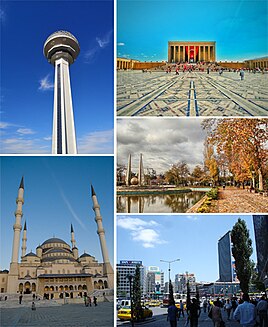Central Anatolia Region
Central Anatolia Region
İç Anadolu Bölgesi | |
|---|---|
 | |
| Country | Turkey |
| Capital | Ankara |
| Provinces | |
| Area | |
| • Total | 163,057 km2 (62,957 sq mi) |
| • Rank | 2nd |
| Population | |
| • Total | 12,896,255 |
| • Density | 79/km2 (200/sq mi) |
| Demonym | Turkish: İç Anadolulu |
| GDP | |
| • Total | US$ 132.208 billion (2022) |
| • Per capita | US$ 10,250 (2022) |
| Time zone | UTC+03:00 (CET) |
| • Summer (DST) | UTC+03:00 (CEST) |
The Central Anatolia Region (Turkish: İç Anadolu Bölgesi) is a geographical region of Turkey. The largest city in the region is Ankara. Other big cities are Konya, Kayseri, Eskişehir, Sivas, and Aksaray.
Located in Central Turkey, it is bordered by the Aegean Region to the west, the Black Sea Region to the north, the Eastern Anatolia Region to the east, and the Mediterranean Region to the south. It also shares a very slight border with the Marmara Region in Bilecik Province.







Subdivisions
[edit]- Konya Section (Turkish: Konya Bölümü)
- Upper Sakarya Section (Turkish: Yukarı Sakarya Bölümü)
- Middle Kızılırmak Section (Turkish: Orta Kızılırmak Bölümü)
- Upper Kızılırmak Section (Turkish: Yukarı Kızılırmak Bölümü)
Ecoregions
[edit]Terrestrial
[edit]Palearctic
[edit]Palearctic regions include:[citation needed]
Temperate broadleaf and mixed forests
[edit]Temperate broadleaf and mixed forests include:[citation needed]
Temperate coniferous forests
[edit]Temperate coniferous forests are Northern Anatolian conifer and deciduous forests.[citation needed]
Temperate grasslands, savannas and shrublands
[edit]Central Anatolian steppe are classified as Temperate grasslands, savannas and shrublands.[citation needed]
Mediterranean forests, woodlands, and scrub
[edit]Mediterranean forests, woodlands, and scrub include:[citation needed]
- Anatolian conifer and deciduous mixed forests
- Southern Anatolian montane conifer and deciduous forests
Provinces
[edit]Provinces that are entirely in the Central Anatolia Region:[citation needed]
Provinces that are mostly in the Central Anatolia Region:[citation needed]
Provinces that are partially in the Central Anatolia Region:[citation needed]
Climate
[edit]Central Anatolia has a semi-arid continental climate with hot, dry summers and cold, snowy winters. Most of the region usually has low precipitation throughout the year.
| Sivas | ||||||||||||||||||||||||||||||||||||||||||||||||||||||||||||
|---|---|---|---|---|---|---|---|---|---|---|---|---|---|---|---|---|---|---|---|---|---|---|---|---|---|---|---|---|---|---|---|---|---|---|---|---|---|---|---|---|---|---|---|---|---|---|---|---|---|---|---|---|---|---|---|---|---|---|---|---|
| Climate chart (explanation) | ||||||||||||||||||||||||||||||||||||||||||||||||||||||||||||
| ||||||||||||||||||||||||||||||||||||||||||||||||||||||||||||
| ||||||||||||||||||||||||||||||||||||||||||||||||||||||||||||
See also
[edit]- Geography of Turkey
- Lycaonia
- Galatia
- Phyrgia
- Anatolia
- Eastern Anatolia Region
- Southeastern Anatolia Region
References
[edit]- ^ "Statistics by Theme > National Accounts > Regional Accounts". www.turkstat.gov.tr. Retrieved 11 May 2023.
- ^ "İl ve İlçelerimize Ait İstatistiki Veriler- Meteoroloji Genel Müdürlüğü". Archived from the original on 2011-06-20. Retrieved 2011-05-31.
External links
[edit] Central Anatolia travel guide from Wikivoyage
Central Anatolia travel guide from Wikivoyage
39°00′N 33°00′E / 39.000°N 33.000°E
Text is available under the CC BY-SA 4.0 license; additional terms may apply.
Images, videos and audio are available under their respective licenses.


